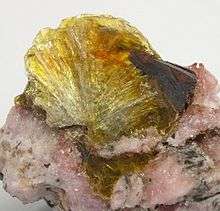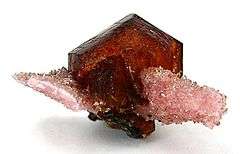Shigaite
| Shigaite | |
|---|---|
|
Reddish-brown shigaite crystal (2 cm across) with pink rhodochrosite from South Africa | |
| General | |
| Category | Sulfate mineral |
| Formula (repeating unit) | NaAl3(Mn2+)6(SO4)2(OH)18·12H2O[1] |
| Strunz classification | 7.DD.35[2] |
| Dana classification | 31.1.2.1[2] |
| Crystal system | Trigonal |
| Crystal class |
Rhombohedral (3) H-M symbol: (3)[2] |
| Space group | R3[3] |
| Unit cell | a = 9.51 Å, c = 32.83 Å,[2] Z = 3[4] |
| Identification | |
| Color | Yellow, burnt orange, brown, black[4] |
| Twinning | On {0001}[4] |
| Cleavage | Perfect on {0001}[4] |
| Tenacity | Moderately flexible[4] |
| Mohs scale hardness | ~2[4] |
| Luster | Vitreous to dull[2] |
| Streak | Very pale yellow to white[4] |
| Diaphaneity | Transparent[2] |
| Specific gravity | 2.32[3] |
| Optical properties | Uniaxial (-)[2] |
| Refractive index | n = 1.546[3] |
| Pleochroism | Distinct; O = yellow; E = very pale yellow[4] |
| Ultraviolet fluorescence | Non-fluorescent[3] |
Shigaite is a mineral with formula NaAl3(Mn2+)6(SO4)2(OH)18·12H2O that typically occurs as small, hexagonal crystals or thin coatings. It is named for Shiga Prefecture, Japan, where it was discovered in 1985.[2] The formula was significantly revised in 1996, identifying sodium as a previously unknown constituent.
Description

Shigaite occurs as hexagonal tabular crystals up to 2 cm (0.79 in) in size or as thin films and coatings. The mineral can be yellow, burnt orange, brown or black in color.[4] Shigaite occurs in metamorphosed deposits of manganese ore[4] and is the Mn2+ analogue of motukoreaite.[5]
Structure
Shigaite consists of oxycation sheets of [AlMn2+2(OH)6]1+ intercalated with oxyanion sheets of [Na(H2O)6{H2O}6(SO4)2]3−. Linkage between the sheets and within the oxyanion sheet results largely through hydrogen bonding.[5]
History
Shigaite was discovered in 1985 in the Ioi Mine,[lower-alpha 1] Shiga Prefecture, Japan.[2] The original study, published in the journal Neues Jahrbuch für Mineralogie, Monatshefte,[1] identified the formula as Al4Mn7(SO4)2(OH)22·8H2O.[6] The formula was significantly revised in 1996 using a sample from the N'Chwaning Mine, South Africa.[5] Sodium, discovered to be a component of shigaite, was not identified in the original study. However, an unidentified volatile had been noted that presumably was a sodium-containing complex.[7]
Distribution
As of 2012, shigaite is known from the following sites:[2]
- Iron Monarch open cut, South Australia, Australia
- Poudrette quarry, Quebec, Canada
- Ioi mine, Shiga Prefecture, Japan
- Wessels Mine, Northern Cape Province, South Africa
- N'Chwaning Mine, Northern Cape Province, South Africa
- Homer Mine, Michigan, United States
- Bengal Mine, Michigan, United States
The type material is housed in the National Museum of Natural History in Washington, D.C. as sample 122089.[4]
Association
Shigaite has been found associated with the following minerals:[4]
|
Ioi mine, Japan
|
Wessels Mine, South Africa
|
Iron Monarch, South Australia
|
Notes
References
| Wikimedia Commons has media related to Shigaite. |
- 1 2 Nickel, Ernest H. "IMA/CNMNC List of Mineral Names" (PDF). Materials Data, Inc. Retrieved May 6, 2012.
- 1 2 3 4 5 6 7 8 9 10 "Shigaite". Mindat. Retrieved April 20, 2012.
- 1 2 3 4 "Shigaite Mineral Data". Webmineral. Retrieved May 20, 2012.
- 1 2 3 4 5 6 7 8 9 10 11 12 "Shigaite" (PDF). Handbook of Mineralogy. Mineral Data Publishing. Retrieved April 20, 2012.
- 1 2 3 Cooper, p. 91.
- 1 2 Hawthorne, Frank C.; et al. (November–December 1986). "New Mineral Names" (PDF). American Mineralogist. 71 (11 & 12): 1546. Retrieved May 17, 2012.
- ↑ Cooper, p. 96.
Bibliography
- Cooper, Mark A.; Hawthorne, Frank C. (February 1996). "The crystal structure of shigaite, (AlMn (super 2+)2 (OH)6)3 (SO4)2 Na(H2O)6 {H2O}6, hydrotalcite-group mineral" (PDF). The Canadian Mineralogist. 34 (1): 91–97. ISSN 0008-4476. Retrieved May 23, 2012.
Further reading
- Pring, A.; Slade, P. G.; Birch, W. D. (September 1992). "Shigaite from Iron Monarch, South Australia" (PDF). Mineralogical Magazine. 56: 417–419. doi:10.1180/minmag.1992.056.384.15. Retrieved April 20, 2012.
